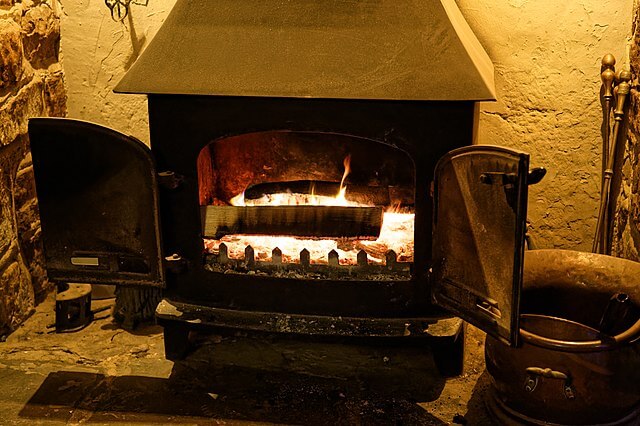
In the UK, air pollution caused by burning wood has doubled in a decade.
According to experts, wood stoves should be regulated by the government because they have evolved into “middle-class status symbols.”
According to official government statistics, the amount of toxic air pollution that homes in the UK emit from burning wood has more than doubled in the past decade.
The report also demonstrated that the single largest contributor to PM2.5 pollution, or particulate matter smaller than 2.5 microns in size, is home solid fuel burning, which includes a small amount of coal. There are fewer PM2.5 emissions from road transportation, industry, and electricity generation from the combustion of wood and other biomass.
Experts suggested that the government should regulate the sale of wood burners in urban areas because they had evolved into “middle-class status symbols.” In effect, the mayor of London outlawed wood-burning stoves in new housing developments last week.
The burning of wood in towns and cities is a major source of the harmful particles that have been linked to a wide range of health issues, including dementia, mental illness in children, and heart and lung disease. In England, polluted air accounts for 26,000 to 38,000 premature deaths annually.
The government report said: “Due to the small size of many of the particles that form PM, some of these toxins may enter the bloodstream and be transported around the body, lodging in the heart, brain and other organs. Therefore, exposure to PM can result in serious impacts to health.”
According to data provided by the government, the decreases realized as a result of the virtually elimination of coal use in power plants and the introduction of stricter emission standards for automobiles and factories have been offset by an increase in emissions caused by wood burners and biomass burning. For the past ten years, the levels of PM2.5 have remained constant.
According to the data, home wood burning accounts for 21% of PM2.5 emissions in the UK and has increased by 124% since 2011. According to the Department of Environment, Food, and Rural Affairs (Defra) report from last year, there will be a 35% increase between 2010 and 2020.
According to officials, the data from 1990 are updated annually to reflect advancements in emission estimation techniques. This year, PM2.5 emissions increased from 2020 to 2021 while 2010 emissions were revised down and 2020 emissions were revised up. They claimed that the rise from 35% to 124% was previously underestimated because of the combination of these factors.
“The increase in PM2.5 from domestic wood burning is a worrying trend that cannot continue if we are serious about protecting both the environment and public health,” said Ross Matthewman, head of policy and campaigns at the Chartered Institute of Environmental Health.
“Now is the time for the UK government to regulate the sale and use of domestic solid wood burners in urban areas where there are on-grid heating alternatives,” he said.
“Rather than providing heating to homes, they have become middle-class status symbols, which harm the quality of our air, damage the environment and threaten public health.”
According to a report by the chief medical officer for England, which stated that the vast majority of the 1.5 million households that burn wood do so for aesthetic reasons, even “eco” wood burners that have been approved by the government produce pollution that is 450 times higher than that produced by gas heating.
In recent years, it has become increasingly apparent how dangerous wood stoves can be in urban areas. Wood-burning stove emissions are to blame for nearly half of the cancer risk brought on by urban air pollution and cost the health of nearly £1 billion per year.
The government recently encouraged local governments to make use of their authority to impose £300 on-the-spot fines on homeowners who break air pollution regulations by burning logs at home. Despite more than 18,000 complaints, English councils have only issued 17 fines over six years due to the difficulty and cost of proving guilt.
A Defra spokesperson said: “This government has delivered significant reductions in emissions since 2010. In that time, emissions of fine particulate matter have fallen by 10%, with nitrogen oxides down by 45%.
“One of the drivers for the 6% rise in PM2.5 emissions in 2021 [compared with 2020] is increased activity post Covid-19 as society emerged from lockdowns,” the spokesperson said.
“Clearly, there is much more to do to tackle this pollutant. That’s why we have legislated to restrict the sale of wet wood and coal, and our new Environmental Improvement Plan sets out further action to meet our long-term targets and ambitious interim targets for PM2.5.”
——————————————————————————
At Natural World Fund, we are passionate about stopping the decline in our wildlife.
The declines in our wildlife is shocking and frightening. Without much more support, many of the animals we know and love will continue in their declines towards extinction.
When you help to restore a patch of degraded land through rewilding to forests, meadows, or wetlands, you have a massive impact on the biodiversity at a local level. You give animals a home and food that they otherwise would not have had, and it has a positive snowball effect for the food chain.
We are convinced that this is much better for the UK than growing lots of fast-growing coniferous trees, solely to remove carbon, that don’t actually help our animals to thrive.
This is why we stand for restoring nature in the UK through responsible rewilding. For us, it is the right thing to do. Let’s do what’s right for nature!
Support our work today at https://naturalworldfund.com/ and join in the solution!

